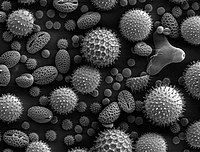
Photo from wikipedia
Trichoid sensilla are the most common mechanoreceptors in insects; depending on their distribution, they can act as either exteroceptors or proprioceptors. In this study, the internal structure of the trichoid… Click to show full abstract
Trichoid sensilla are the most common mechanoreceptors in insects; depending on their distribution, they can act as either exteroceptors or proprioceptors. In this study, the internal structure of the trichoid sensillum from Nilaparvata lugens was studied, using focused ion beam scanning electron microscopy (FIB-SEM). We reconstructed a three-dimensional (3D) model derived from the FIB-SEM data set. The model displayed characteristic mechanosensory sensilla components, including a hair inserted in the socket, a dendrite going through the laminated cuticle, and an electron-dense tubular body at the dendrite terminal. The detailed 3D model showed the relationship between the microtubules within the tubular body and those outside of the tubular body. We also found an autocellular junction in the tormogen cell, indicating that the tormogen cell grows around the dendrite sheath to form a hollow column shape during sensilla morphogenesis.
Journal Title: Cell and Tissue Research
Year Published: 2019
Link to full text (if available)
Share on Social Media: Sign Up to like & get
recommendations!